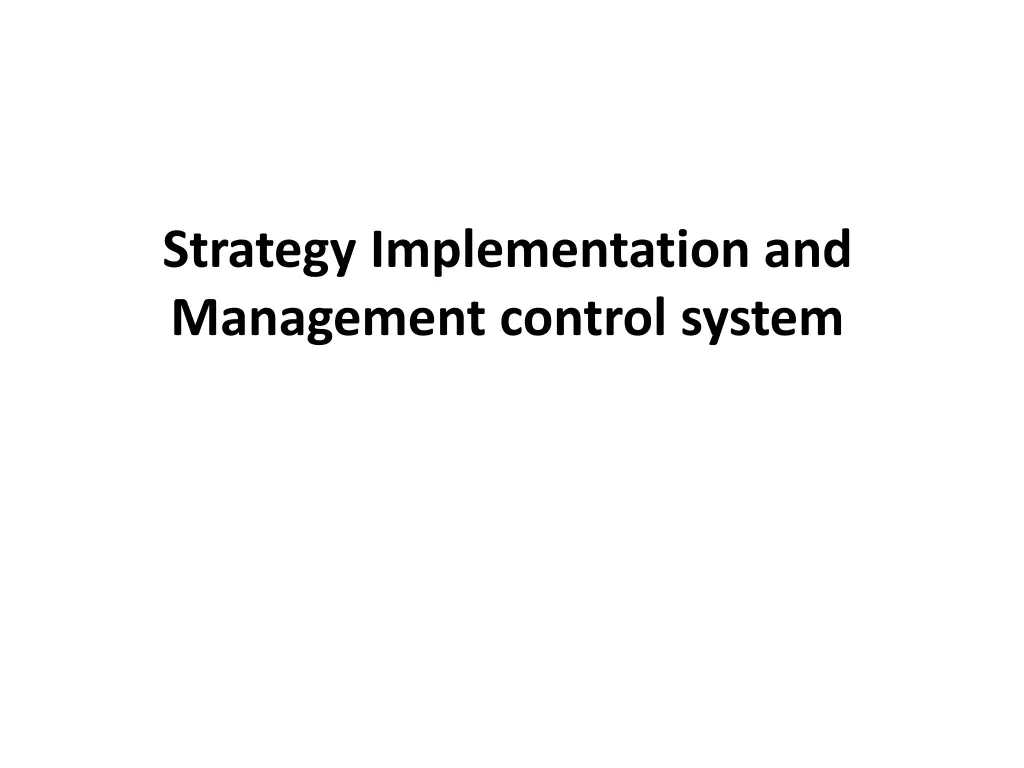
Effective Strategies for Change Management in Organizations
Discover the critical steps and key strategies for successful implementation of change management in organizations. Learn about aligning initiatives, budget, and performance, engaging staff, and monitoring progress to achieve strategic objectives efficiently. Explore the proactive management of strategic change and its impact on organizational development.
Uploaded on | 0 Views
Download Presentation

Please find below an Image/Link to download the presentation.
The content on the website is provided AS IS for your information and personal use only. It may not be sold, licensed, or shared on other websites without obtaining consent from the author. If you encounter any issues during the download, it is possible that the publisher has removed the file from their server.
You are allowed to download the files provided on this website for personal or commercial use, subject to the condition that they are used lawfully. All files are the property of their respective owners.
The content on the website is provided AS IS for your information and personal use only. It may not be sold, licensed, or shared on other websites without obtaining consent from the author.
E N D
Presentation Transcript
Strategy Implementation and Management control system
Build Execution Its often : Our strategy was great but failed to execute 1.60% of the company budgets are not linked to the strategy 2. 30% staff incentives are not linked to strategy 3. Only 10% of the employee understand the strategy
FIVE critical steps of strategy implementation Align your initiatives Align budget and performance Structure follows strategy Engaging staff Monitor and adapt
Managing Strategic Change during strategy implementation
Change Changes takes place continuously within the organization to manage Japanizes believes small changes within the organization bring much more bigger results in the future (Kaizan). The pace of change can be represented by two extremes. Slow organizational change Fast organizational change the operations.
What is strategic change Strategic change is proactive management of change in organization to achieve clearly identified objective. Proactive means that company takes initiatives to manage new strategies to overcome a strategic issue or strategic opportunity( Consumer habit changes) and managing its impact on organizational employees.
Pressure points of strategic change Strategic change is primarily with people and tasks they perform in the organization. Understanding the pressure points for influencing such a change is important if the change is to be effective. Its undertaken through formal and informal structure of the organization
Tychy's FOUR main causes of strategic change Environment Business relationships Technology People
Managing strategic change Perspective approach to managing strategic change Emergent approach to managing strategic change
Managing challenges of perspective change Kert Lewin (1950) three step model Unfreezing current attitude Moving to a new level Refreezing attitude at the new level
Management Control System A management control system is a logical integration of management accounting tools to gather and report data and to evaluate performance.
The Management Control System Set Goals, Measures, Targets Plan and Execute Feedback and Learning Evaluate, Reward Monitor, Report
Developing a Management Control System 1.Begin by specifying the organization's goals, sub goals and objectives Goals are what the organization hopes to achieve in the long run Sub goals or key success factors are more specific and provide more focus to guide daily actions Objectives are specific benchmarks which management would like to see achieved Important to keep all three in balance to avoid concentrating solely on short-run achievements at the expense of long run goals 2. Establish responsibility centers 3. Develop performance measures 4. Measure and report on financial performance 5. Measure and report on non-financial performance
Setting Goals, Objectives and Performance Measures Top management develops organization-wide goals, measures and targets. Top management and critical process managers develop critical success factors and performance measures. They also specify objectives Critical process managers and lower-level managers develop performance measures for objectives.
Successful Organizations and Measures of Achievement FINANCIAL STRENGTH CUSTOMER SATISFACTION BUSINESSS PROCESS IMPROVEMENTS ORGANIZATIONAL LEARNING
Balanced Scorecard Performance reporting approach which links organizational strategy to actions of managers and employees Combines financial and operating measures Links performance to rewards Recognizes diversity in organizational goals Financial Strength Customer Satisfaction Organizational Learning Business Process Improvement




